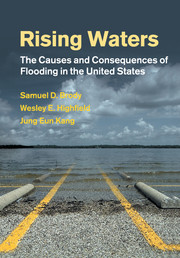Book contents
- Frontmatter
- Contents
- Preface
- Acknowledgments
- Abbreviations
- 1 Introduction: rising waters
- Part I The consequences of floods
- Part II Planning decisions and flood attenuation
- Part III What are we learning?
- 9 Policy learning for local flood mitigation
- 10 Local case studies in Texas and Florida
- Part IV Policy implications and recommendations
- 12 Conclusions
- References
- Index
9 - Policy learning for local flood mitigation
from Part III - What are we learning?
Published online by Cambridge University Press: 28 April 2011
- Frontmatter
- Contents
- Preface
- Acknowledgments
- Abbreviations
- 1 Introduction: rising waters
- Part I The consequences of floods
- Part II Planning decisions and flood attenuation
- Part III What are we learning?
- 9 Policy learning for local flood mitigation
- 10 Local case studies in Texas and Florida
- Part IV Policy implications and recommendations
- 12 Conclusions
- References
- Index
Summary
Most research on flood mitigation assumes it is a policy endeavor that is fixed in time. Longitudinal studies that track how communities adjust their flood policies in response to various stimuli are the exception. However, in reality, local policy making is a long-term process where decision makers constantly revise their strategies to address flooding and other natural hazard concerns. Shifting socioeconomic, political, and geophysical landscapes require that local plans and policies be evolving instruments. The ultimate success of a community in terms of becoming resilient to floods, then, may depend on its ability to learn.
In this chapter, we longitudinally explore the local flood mitigation problem by focusing on how jurisdictions change their policies in response to repetitive flood events. By examining the drivers of policy change, we can better understand the degree to which communities improve their mitigation capabilities in the face of chronic flood events. Furthermore, identifying the levers of learning for flood mitigation will inform communities outside the study area on how best to speed the process of adopting flood reduction policies and take a more proactive approach to mitigating the adverse impacts of floods before they occur.
Initially, we draw upon the adaptive management and policy learning literature as a framework for empirically investigating the topic. Then, we focus on Florida as the learning laboratory in which to track policy change: first, we examine the degree to which communities in Florida alter their flood policies across two generations of comprehensive plans, and, second, we observe how counties across the state change their CRS policies over time in response to multiple drivers including flood damage, socioeconomic factors, and physical risk variables.
- Type
- Chapter
- Information
- Rising WatersThe Causes and Consequences of Flooding in the United States, pp. 141 - 156Publisher: Cambridge University PressPrint publication year: 2011



